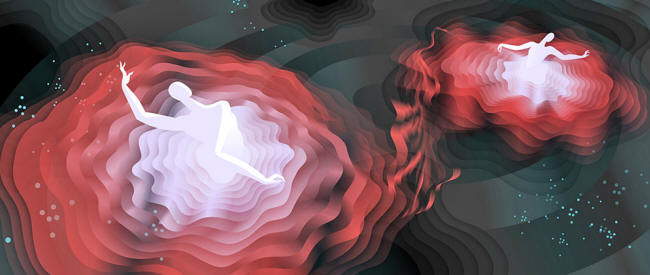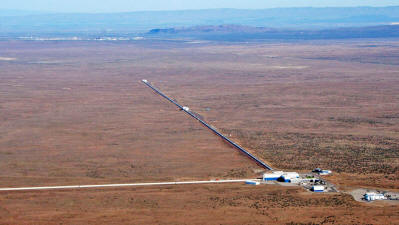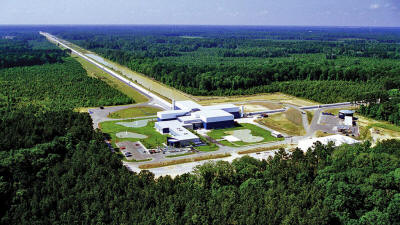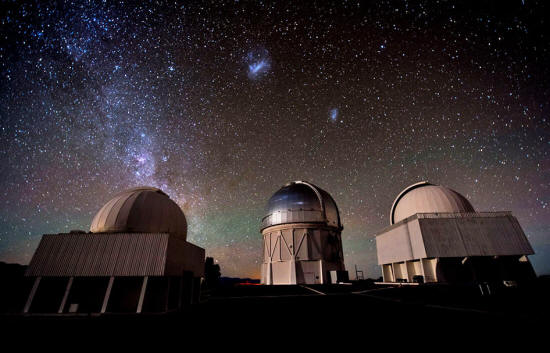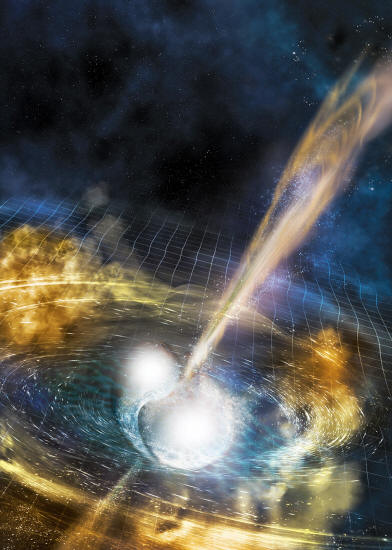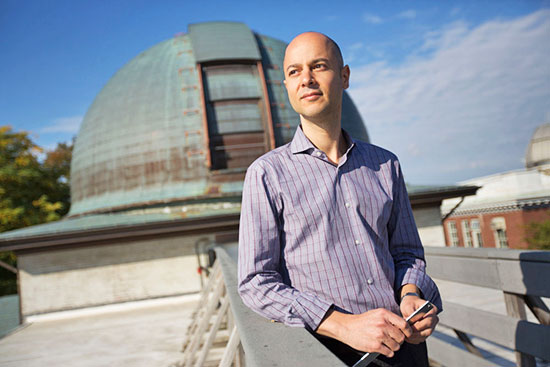|
from
QuantaMagazine Website
for Quanta Magazine
led to a rumble of gravitational waves and a worldwide race to spot the resulting kilonova.
The dozens of studies coming out of the effort will
"go down in the history of
astronomy."
On Aug. 17, the Laser Interferometer Gravitational-Wave Observatory (LIGO) detected something new.
Some 130 million
light-years away, two super-dense
neutron stars, each as small as a
city but heavier than the sun, had crashed into each other,
producing a colossal convulsion called a
kilonova
and sending a
telltale ripple through space-time to Earth.
But when his office phone rang, he ignored it. Shortly afterward, his cellphone rang.
He glanced at the display to discover a flurry of missed text messages:
LIGO's pair of ultrasensitive detectors in Louisiana and Washington state made history two years ago by recording the gravitational waves coming from the collision of two black holes - a discovery that earned the experiment's architects the Nobel Prize in Physics this month.
Three more signals from black hole collisions followed the initial discovery.
Yet black holes don't give off light, so making any observations of these faraway cataclysms beyond the gravitational waves themselves was unlikely. Colliding neutron stars, on the other hand, produce fireworks.
Astronomers had never seen such a show before, but now LIGO was telling them where to look, which sent teams of researchers like Berger's scurrying to capture the immediate aftermath of the collision across the full range of electromagnetic signals.
In total, more than 70 telescopes swiveled toward the same location in the sky. They struck the motherlode...
In the days after Aug. 17, astronomers made successful observations of the colliding neutron stars with optical, radio, X-ray, gamma-ray, infrared and ultraviolet telescopes.
The enormous collaborative effort, detailed today in dozens of papers appearing simultaneously in,
...and other journals, has not only allowed astrophysicists to piece together a coherent account of the event, but also to answer longstanding questions in astrophysics.
Today, Berger said,
X Marks the Spot
When Berger got the calls, emails, and the automated official LIGO alert with the probable coordinates of what appeared to be a neutron-star merger, he knew that he and his team had to act quickly to see its aftermath using optical telescopes.
The timing was fortuitous. Virgo, a new gravitational-wave observatory similar to LIGO's two detectors, had just come online in Europe. The three gravitational-wave detectors together were able to triangulate the signal.
Had the neutron-star merger occurred a month or two earlier, before Virgo started taking data, the "error box," or area in the sky that the signal could have come from, would have been so large that follow-up observers would have had little chance of finding anything.
The LIGO and Virgo scientists had another stroke of luck. Gravitational waves produced by merging neutron stars are fainter than those from black holes and harder to detect.
According to Thomas Dent, an astrophysicist at the Albert Einstein Institute in Hannover, Germany, and a member of LIGO, the experiment can only sense neutron-star mergers that occur within 300 million light-years.
This event was far closer - at a comfortable distance for both LIGO and the full range of electromagnetic telescopes to observe it.
But at the time, Berger and his colleagues didn't know any of that. They had an agonizing wait until sunset in Chile, when they could use an instrument called the Dark Energy Camera mounted on the Victor M. Blanco telescope there.
The camera is great when you don't know precisely where you're looking, astronomers said, because it can quickly scan a very large area of the sky.
Berger also secured use of, (Other teams that received the LIGO alert asked to use VLA and ALMA as well.)
A few hours later, data from the Dark Energy Camera started coming in. It took Berger's team 45 minutes to spot a new bright light source.
The light appeared to come from a galaxy called NGC 4993 in the constellation Hydra that had been pointed out in the LIGO alert, and at approximately the distance where LIGO had suggested they look.
The team had expected a long slog, maybe having to wade through multiple searches after LIGO detections for a couple of years until eventually spotting something.
Meanwhile, at least five other teams discovered the new bright light source independently, and hundreds of researchers made various follow-up observations.
David Coulter, an astronomer at University of California, Santa Cruz, and colleagues used the Swope telescope in Chile to pinpoint the event's exact location, while Las Cumbres Observatory (LCO) astronomers did so with the help of a robotic network of 20 telescopes around the globe.
For Berger and the rest of the Dark Energy Camera follow-up team, it was time to call in the Hubble Space Telescope (HST).
Securing time on the veteran instrument usually takes weeks, if not months. But for extraordinary circumstances, there's a way to jump ahead in line, by using "director's discretionary time."
Matt Nicholl, an astronomer at the Harvard-Smithsonian Center for Astrophysics, submitted a proposal on behalf of the team to take ultraviolet measurements with Hubble - possibly the shortest proposal ever written.
As the data trickled in from the various instruments, the collected data set was becoming more and more astounding.
In total, the original LIGO/Virgo discovery and the various follow-up observations by scientists have yielded dozens of papers, each describing astrophysical processes that occurred during and after the merger.
Mystery Bursts
Neutron stars are compact neutron-packed cores left over when massive stars die in supernova explosions.
A teaspoon of neutron star would weigh as much as one billion tons. Their internal structure is not completely understood. Neither is their occasional aggregation into close-knit binary pairs of stars that orbit each other.
The astronomers Joe Taylor and Russell Hulse found the first such pair in 1974, a discovery that earned them the 1993 Nobel Prize in Physics.
They concluded that those two neutron stars were destined to crash into each other in about 300 million years. The two stars newly discovered by LIGO took far longer to do so.
The analysis by Berger and his team suggests that the newly discovered pair was born 11 billion years ago, when two massive stars went supernova a few million years apart.
Between these two explosions, something brought the stars closer together, and they went on circling each other for most of the history of the universe.
The findings are,
The merger also solved another mystery that has vexed astrophysicists for the past five decades.
On July 2, 1967, two United States satellites, Vela 3 and 4, spotted a flash of gamma radiation. Researchers first suspected a secret nuclear test conducted by the Soviet Union.
They soon realized this flash was something else:
The origin of GRBs has been an enigma, although some people have suggested that so-called "short" gamma-ray bursts (lasting less than two seconds) could be the result of neutron-star mergers.
There was no way to directly check until now.
In yet another nod of good fortune, it so happened that on Aug. 17, the Fermi Gamma-Ray Space Telescope (FGST) and the International Gamma-Ray Astrophysics Laboratory (INTEGRAL) were pointing in the direction of the constellation Hydra.
Just as LIGO and Virgo detected gravitational waves, the gamma-ray space telescopes picked up a weak GRB, and, like LIGO and Virgo, issued an alert.
A neutron star merger should trigger a very strong gamma-ray burst, with most of the energy released in a fairly narrow beam called a jet. The researchers believe that the GRB signal hitting Earth was weak only because the jet was pointing at an angle away from us.
Proof arrived about two weeks later, when observatories detected the X-ray and radio emissions that accompany a GRB.
Hughes said that the observations were the first in which,
The findings indicate that at least some GRBs come from colliding neutron stars, though it's too soon to say whether they all do.
Striking Gold
Optical and infrared data captured after the neutron-star merger also help clarify the formation of the heaviest elements in the universe, like uranium, platinum and gold, in what's called r-process nucleo-synthesis.
Scientists long believed that these rare, heavy elements, like most other elements, are made during high-energy events such as supernovas. A competing theory that has gained prominence in recent years argues that neutron-star mergers could forge the majority of these elements.
According to that thinking, the crash of neutron stars ejects matter in what's called a kilonova.
Optical telescopes picked up the radioactive glow of these heavy elements - strong evidence, scientists say, that neutron-star collisions produce much of the universe's supply of heavy elements like gold.
According to Daniel Holz, an astrophysicist at the University of Chicago,
The scientists also inferred a sequence of events that may have followed the neutron-star collision, providing insight into the stars' internal structure.
Experts knew that the collision outcome,
If the stars are extra soft, they may immediately be swallowed up inside a newly formed black hole, but this would not leave any matter outside to produce a gamma-ray burst.
The most plausible case may lie somewhere in the middle:
Future observations of neutron-star mergers will settle these questions.
And as the signals roll in, experts say the mergers will also serve as a precision tool for cosmologists.
Comparing the gravitational-wave signal with the redshift, or stretching, of the electromagnetic signals offers a new way of measuring the so-called Hubble constant, which gives the age and expansion rate of the universe.
Already, with this one merger, researchers were able to make an initial measurement of the Hubble constant,
Holz described the neutron star merger as a "standard siren" (in a nod to the term "standard candles" used for supernovas) and said that initial calculations suggest the universe is expanding at a rate of 70 kilometers per second per megaparsec, which puts LIGO's Hubble constant,
To improve the measurement, scientists will have to spot many more neutron-star mergers.
Given that LIGO and Virgo are still being fine-tuned to increase their sensitivity, Berger is optimistic.
|


